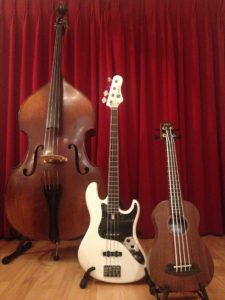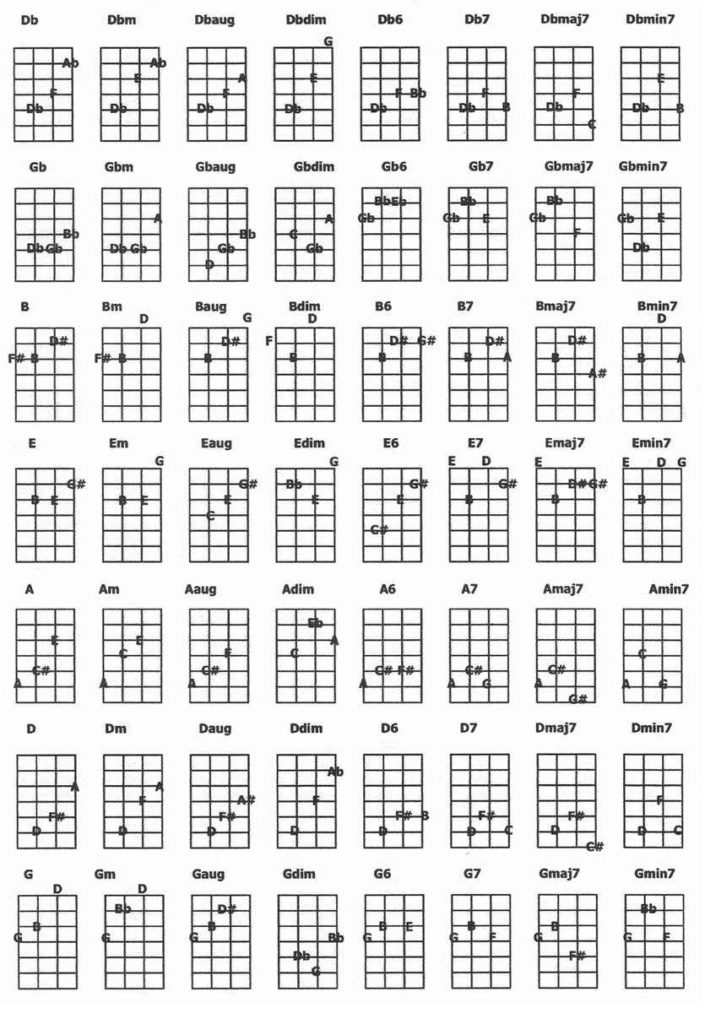 The first electric bass guitar was manufactured in the 1930s but it wasn’t very successful. Fender developed the guitar version of the bass in 1951. If you wanted to be the bass player in a band, it meant lugging one of those huge upright double-basses you see in orchestras, blues bands and jazz bands.
The first electric bass guitar was manufactured in the 1930s but it wasn’t very successful. Fender developed the guitar version of the bass in 1951. If you wanted to be the bass player in a band, it meant lugging one of those huge upright double-basses you see in orchestras, blues bands and jazz bands.
Contents
- 1 Bass Guitar: Introduction
- 1.1 The role of the bass guitarist
- 1.2 There are two ways we can pluck a bass string
- 1.3 The two main things to make sure of when playing the Bass Guitar
- 1.4 Tips for Good Bass Guitar Playing
- 1.5 Slapping and popping on the Bass Guitar
- 1.6 Bass Guitar Essential Accessories
- 1.7 The Power of Consistent Guitar Practice
- 1.8 Beginner's Guide to Bass Guitar
Bass Guitar: Introduction
Each of the 4 strings on a bass guitar has a name and a number
To learn how to play the bass guitar you’ll need to know the notes of the strings. The four strings of a bass guitar are tuned the same as the lower four strings of a guitar.
- The 4th string is tuned to E. So it’s usually referred to as the ‘low E string‘. This is the deepest/lowest bass note you can play.
- The 3rd string is tuned to A, so it’s usually referred to as the A string.
- The 2nd string is tuned to D, so it’s usually referred to as the D string.
- The 1st string and it’s tuned to G, so it’s usually referred to as the G string.
These notes are the same as a guitar but they’re an octave lower. That means they sound deeper and lower.

The role of the bass guitarist
The role of the bass guitarist is to provide a solid beat (along with the drummer) that provides the rhythmic foundation of a piece of music.
- The bass guitar in a band plays what’s called ‘the bass line’.
- Lead guitars play a lot of high up treble stuff and rhythm guitars tend to play chords somewhere in the mid area.
- As a bass guitarist, you fill out the low end and that gives us an overall well-rounded sound.
There are two ways we can pluck a bass string
- Using a guitar pick
- Using the first two fingers of the picking hand.
Using a pick, we want to use down and upstrokes to keep a nice, steady groove going on our G note.
Using the two fingers, we want to alternate between the two in a sort of ‘walking’ motion on the string.
The two main things to make sure of when playing the Bass Guitar
-
- Playing the right root note for the right chord
- Playing it in time.
If you want to play the bass guitar, your timing has got to be impeccable.
Learning how to play the bass guitar takes time and you can build up to doing complicated thumb-slap stuff in the future.
Remember, as a bass guitarist, you and the drummer form the core of the rhythm section of a band. With that in mind, it’s important to keep things rhythmic. It is important to remember however that roots form the foundations of our bass lines.
A bassist who plays nothing but roots, but makes sure they are the correct roots played at the correct rhythm and tempo will always be better than a bassist who plays all over the fretboard with no regard for the chord sequence or song structure.
If you want to play and be a strong bass guitarist you need to learn and be comfortable using all your fingers and thumb not just hopping around using two fingers
The bass line should sound a bit varied but still have a nice solid root based feel. You can be creative and make the bass line your own.
The bass player’s golden rule: If In Doubt, Play The Root Note
Tips for Good Bass Guitar Playing
- If in doubt, keep it SIMPLE. A simple bass line is better than being all over the fretboard.
- Try playing along with the song when practising. Playing along with an original song will help with your timing. Make sure you can hear the song and your bass.
- When you’re not playing, be LISTENING. When you are listening to a song listen to what the bass guitar is doing.
- How is it working with the other instruments?
- Is it always playing the same rhythm or is it playing a different but complementary rhythm?
- Can you hear any root notes or other notes?
- Do some bassists play busier bass lines than others?
- Do different styles of music feature different types of bass lines?
- Is the bass guitar more prominent on some records than others?
Listening to these will help you understand the role of the bass guitarist better and help realize what might be expected of you as you play the bass guitar.
Learn to read tabs carefully and accurately. If you’re looking to do a cover version of a song, you can’t go too far wrong by following the tab, so long as it’s an accurate tab.
Slapping and popping on the Bass Guitar
These are difficult techniques and will take a while before a beginner will be able to do these.
- Slapping refers to when we whack the string with the edge of the thumb.
- Popping refers to when we grip a string from underneath and twang it.
Learn how to play bass guitar basics first!


Pingback: A Beginner’s Guide to Bass Guitar